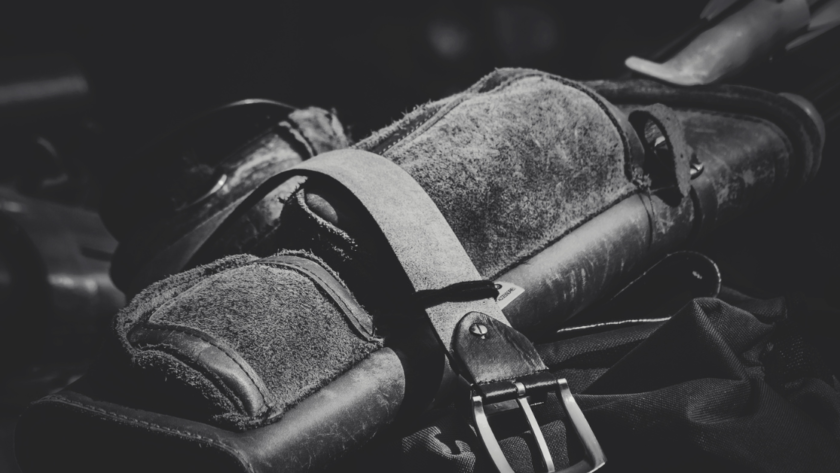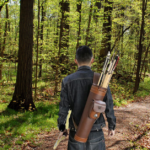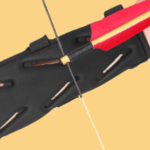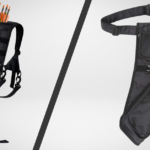The Evolution of Rugged Quivers
The Safari Tuff line represents a quantum leap in quiver technology. These quivers are the culmination of years of intensive research, rigorous field testing, and highly valuable design innovations.
The engineers behind Safari Tuff recognized that traditional quivers often fell short in extreme conditions, leaving archers and bowhunters frustrated when their equipment failed at critical moments.
By harnessing the power of advanced polymers and cutting-edge composites, Safari Tuff has created quivers that offer an unmatched combination of strength, lightweight construction, and resistance to the elements. These quivers are built to withstand the most punishing environments on Earth, from the searing heat of desert landscapes to the bone-chilling cold of arctic tundras.
The materials used in Safari Tuff quivers undergo extensive testing to confirm they can handle not just the occasional light rain, and prolonged exposure to harsh UV radiation, corrosive chemicals, and extreme temperature fluctuations. This level of durability gives archers the confidence to push their limits, knowing their equipment won’t let them down when it matters most.
Silence is Golden: Noise Reduction Technology
One of the standout features of Safari Tuff quivers is their pioneering noise reduction technology. In hunting scenarios, a noisy quiver can be more than just an annoyance – it can be the difference between a successful hunt and going home empty-handed.
Traditional quivers are notorious for producing unwanted sounds as arrows shift and rattle with movement. Safari Tuff has tackled this problem head-on by incorporating specialized dampening materials throughout their quiver designs.
These materials absorb vibrations and prevent arrows from making contact with hard surfaces, effectively eliminating the telltale clatter that can alert prey to a hunter’s presence.
The arrow grips in Safari Tuff quivers are another key component of their noise reduction strategy. These grips are engineered to hold arrows securely in place, even when navigating through dense underbrush or scaling rocky terrain. The result is a quiver that stays whisper-quiet in even the most challenging conditions, allowing hunters to move with stealth and confidence.
This noise reduction technology isn’t just useful for hunting. It also enhances the overall archery experience by reducing distractions and allowing archers to focus fully on their form and technique.
Practical Applications Beyond Hunting
While Safari Tuff quivers excel in hunting scenarios, their versatility extends far beyond the realm of pursuing game. These quivers have found applications in various archery disciplines and outdoor activities:
Wilderness Archery
For archers who enjoy practicing their craft in remote, rugged locations, Safari Tuff quivers offer unparalleled protection for arrows. The durable construction shields arrows from damage caused by impacts, moisture, and debris, ensuring they stay in pristine condition even after long treks through challenging terrain.
Competitive Field Archery
In the fast-paced world of competitive field archery, every second counts. Safari Tuff quivers feature quick-release mechanisms and customizable configurations that allow archers to access their arrows swiftly and efficiently.
This can be a game-changer in competitions where speed and adaptability are crucial factors in determining success.
Survival Training
The robust design and enough capacity of Safari Tuff quivers make them ideal for survival training scenarios. In addition to carrying arrows, these quivers can be adapted to hold small survival tools, making them a versatile piece of equipment for those honing their wilderness skills.
Extreme Weather Archery
Archers who refuse to let inclement weather interfere with their passion will find Safari Tuff quivers to be invaluable companions. Whether shooting in driving rain, heavy snow, or scorching heat, these quivers keep arrows protected and in prime condition.
The weather-resistant materials prevent warping, rusting, and other forms of weather-related damage that can compromise arrow performance.
Overcoming Common Quiver Challenges
Safari Tuff quivers address several longstanding issues that have plagued archers for years:
Weight Distribution
One of the most significant problems with traditional quivers is their impact on bow balance. A poorly designed quiver can throw off an archer’s aim and make consistent shooting difficult.
Safari Tuff models are engineered with optimal weight distribution in mind.
The quivers are designed to combine seamlessly with the bow, maintaining it’s natural balance and ensuring that performance isn’t compromised.
The engineers at Safari Tuff have spent countless hours fine-tuning the weight distribution of their quivers. They’ve conducted extensive testing with archers of various skill levels to decide the ideal placement of weight that minimizes interference with shooting mechanics.
The result is a quiver that feels like a natural extension of the bow, as opposed to an awkward add-on.
Capacity vs. Bulk
Many high-capacity quivers become unwieldy, forcing archers to choose between carrying enough arrows and maintaining maneuverability. Safari Tuff has cracked this code by developing designs that maximize arrow capacity without significantly increasing bulk or weight.
Through clever use of space and innovative arrow storage solutions, Safari Tuff quivers can hold more arrows than many competitors while maintaining a sleek profile. This is achieved through a combination of compact design and the use of lightweight yet strong materials.
Archers can carry a full complement of arrows without feeling weighed down or encumbered.
Durability Concerns
The materials used in Safari Tuff quivers undergo rigorous testing to confirm they can withstand the harshest conditions. These quivers are built to resist impacts, UV exposure, and even chemical exposure from common outdoor products like bug spray and sunscreen.
The polymer blends and composites used in Safari Tuff quivers are the result of years of research and development. These materials offer superior strength-to-weight ratios, allowing for robust protection without adding unnecessary heft. The durability of these quivers means they often outlast many other pieces of archery equipment, providing excellent long-term value for archers.
Implementing Safari Tuff in Your Setup
Integrating a Safari Tuff quiver into your archery setup is a straightforward process, but there are several steps you can take to confirm you’re maximizing it’s potential:
Choose the Right Model
Safari Tuff offers a range of quiver models, each tailored to different needs and preferences. When selecting a quiver, consider the following factors:
- Bow type: Ensure the quiver is compatible with your specific bow model.
- Arrow capacity: Determine how many arrows you typically need to carry.
- Shooting environment: Consider the terrain and weather conditions you’ll be facing.
Take the time to research different models and read user reviews. If possible, visit a local archery shop to handle the quivers in person and get expert advice on which model might best suit your needs.
Mounting Options
Experiment with different mounting positions to find the setup that works best for you. Some archers prefer a hip quiver for improved balance and ease of movement, while others opt for bow-mounted configurations for quick access to arrows.
If you choose a bow-mounted quiver, pay attention to how it affects your bow’s balance and your shooting form. You may need to make slight adjustments to your technique to accommodate the added weight and bulk of the quiver.
For those who prefer hip quivers, practice drawing arrows smoothly and efficiently from various positions. This will help you develop muscle memory and improve your overall shooting speed and accuracy.
Customize for Comfort
Many Safari Tuff models offer modular components that allow for extensive customization. Take advantage of these features to create a setup that’s perfectly tailored to your needs and preferences.
Adjust the angle and position of arrow grips to find the most comfortable and efficient arrangement. Experiment with different accessory attachments to improve your quiver’s functionality.
Don’t be afraid to make small tweaks and adjustments as you become more familiar with your new quiver.
Test in Various Conditions
Before heading out on a major expedition or important hunt, thoroughly test your Safari Tuff quiver setup in a variety of conditions. This will help you identify any potential issues and fine-tune your configuration.
Practice shooting in different weather conditions, terrains, and positions. Pay attention to how the quiver affects your balance, draw cycle, and overall shooting comfort.
Make note of any areas that need improvement and adjust accordingly.
Maintain Regularly
While Safari Tuff quivers are incredibly durable, regular maintenance will confirm optimal performance and longevity. Develop a routine for cleaning and inspecting your quiver:
- Clean the quiver after each use, removing any dirt, debris, or moisture.
- Inspect arrow grips and dampening materials for signs of wear.
- Check all mounting hardware and tighten as necessary.
- Lubricate any moving parts according to the manufacturer’s recommendations.
By staying on top of maintenance, you’ll keep your quiver in peak condition and be able to rely on it for years to come.
Potential Pitfalls and How to Avoid Them
Even the best gear can be misused. Here are some common mistakes to avoid with Safari Tuff quivers:
Overloading
The high capacity of Safari Tuff quivers can be tempting, but resist the urge to overload your quiver simply because you can. Carrying too many arrows can negatively impact your mobility and shooting performance.
Instead, carefully consider your needs for each outing and pack accordingly. For most hunting situations, 6-8 arrows are typically enough.
If you’re participating in a 3D archery competition, you might need a few more.
Find the right balance that allows you to carry what you need without compromising your shooting ability.
Neglecting Adjustments
Safari Tuff quivers are highly adjustable, but many archers make the mistake of using the out-of-the-box setup without customizing it to their needs. Take the time to fine-tune your quiver’s position, angle, and configuration.
Experiment with different setups during practice sessions. Pay attention to how small adjustments affect your comfort and shooting performance.
Don’t be afraid to make changes – the goal is to create a setup that feels like a natural extension of your bow and shooting style.
Ignoring Compatibility
While Safari Tuff quivers are designed to be versatile, it’s crucial to confirm that your chosen model is fully compatible with your bow and other accessories. Incompatibility issues can lead to poor performance, damage to your equipment, or even safety hazards.
Before purchasing, carefully check the specifications of both your bow and the quiver. If you’re unsure about compatibility, reach out to Safari Tuff’s customer support or ask with a knowledgeable archery technician.
Forgetting to Secure
Always double-check that your quiver is securely attached before heading out, especially if you’ve recently adjusted it. A loose quiver can be noisy, affect your bow’s balance, or even fall off at an inopportune moment.
Develop a pre-shoot checklist that includes verifying the security of your quiver. This simple step can prevent frustration and potential equipment loss in the field.
Adapting to Different Scenarios
The true beauty of Safari Tuff quivers comes from their adaptability. Here’s how to make the most of them in various situations:
For the Treestand Hunter
When hunting from a treestand, weight and maneuverability are crucial factors. Opt for a Safari Tuff model with a quick-detach system.
This allows you to easily remove the quiver once you’re settled in your stand, reducing overall weight and improving your shooting profile.
Practice attaching and detaching your quiver quietly and efficiently. This skill will come in handy when you need to make quick adjustments in the field without alerting nearby game.
Consider using a smaller capacity quiver for treestand hunting, as you typically won’t need as many arrows compared to spot-and-stalk hunting. This can further reduce weight and improve your overall comfort during long sits.
For the Spot-and-Stalk Bowhunter
Spot-and-stalk hunting needs a quiver that excels in noise reduction and allows for most mobility. Choose a Safari Tuff model with top-of-the-line noise reduction features to keep your arrows silent as you move through brush and uneven terrain.
Consider a hip-mounted option for improved mobility when crawling or crouching. This configuration keeps the weight off your bow and allows for more natural movement as you stalk your prey.
Practice drawing arrows smoothly and quietly from your quiver while in various positions – standing, kneeling, and even prone. The ability to access your arrows silently and efficiently can make all the difference when you’re closing in on wary game.
For the 3D Archer
In 3D archery competitions, speed and arrow selection are critical. Look for Safari Tuff models with easy arrow access and organization features.
Being able to quickly choose the right arrow for each target can significantly improve your performance.
Consider a quiver with color-coded or labeled arrow slots to help you quickly identify different arrow types or fletching configurations. This can save precious seconds during timed events.
Practice your arrow selection and nocking process to develop a smooth, efficient routine. The less time you spend fumbling with your quiver, the more time you’ll have to focus on your shot execution.
For the Wilderness Trekker
For those who combine archery with extended wilderness expeditions, prioritize Safari Tuff models with the highest durability ratings. Look for features like integrated tool storage or hydration compatibility to maximize the utility of your quiver during long treks.
Consider a quiver with modular attachment points that allow you to add or remove accessories based on the specific needs of each trip. This versatility can be invaluable when facing diverse environments and challenges.
Practice packing your quiver efficiently, balancing arrow capacity with the storage of essential survival gear. Develop a system that allows you to access both your arrows and other equipment quickly and easily.
Building on the Basics
Understanding the advanced features of Safari Tuff quivers needs a solid foundation in basic archery principles. Here’s how this knowledge elevates your game:
Arrow Protection
A deep understanding of how different elements affect arrow flight helps you appreciate the protective qualities of Safari Tuff quivers. Factors like moisture, temperature fluctuations, and physical impacts can all compromise arrow performance.
Safari Tuff quivers are designed to shield your arrows from these detrimental factors. The materials used in their construction create a barrier against moisture, preventing warping and degradation of wooden arrows or delamination of carbon arrows.
The arrow grips in Safari Tuff quivers are engineered to hold arrows securely without putting undue stress on the shafts or fletching. This prevents warping or damage that could occur if arrows were allowed to rattle around loosely.
By protecting your arrows from the elements and physical damage, Safari Tuff quivers help confirm consistent performance shot after shot, even in challenging conditions.
Bow Balance
A thorough understanding of bow mechanics allows you to fine-tune your quiver setup for optimal performance. The addition of a quiver to your bow changes it’s weight distribution, which can affect your shooting form and accuracy.
Safari Tuff quivers are designed with bow balance in mind. Their lightweight construction and thoughtful attachment points minimize the impact on your bow’s natural balance.
However, it’s still important to experiment with different mounting positions to find the setup that works best for your shooting style.
Pay attention to how the quiver affects your bow’s behavior during the draw cycle and at full draw. Make small adjustments to the quiver’s position until you find the sweet spot where it feels like a natural extension of your bow.
Stealth Techniques
Recognizing the importance of noise reduction in hunting scenarios highlights the value of Safari Tuff’s silent design. Successful bowhunting often comes down to the ability to move quietly and avoid detection.
The noise reduction features of Safari Tuff quivers complement other stealth techniques you may employ. Practice moving slowly and deliberately with your quiver attached, paying attention to how it interacts with your surroundings.
Use the quiver’s silent design to your advantage when stalking game or setting up for a shot. The confidence that comes from knowing your equipment won’t give you away allows you to focus fully on the hunt.
Practical Exercises to Master Your Safari Tuff Quiver
To truly become proficient with your Safari Tuff quiver, incorporate these exercises into your training routine:
The Silent Stalk
Set up an obstacle course in your backyard or a local practice area. Include various terrains and obstacles you might encounter while hunting, such as brush, logs, and uneven ground.
Practice moving through this course with your quiver attached, focusing on minimizing noise.
Start slowly, paying close attention to how your quiver interacts with your surroundings. As you become more comfortable, gradually increase your speed while maintaining stealth.
This exercise will help you develop the body awareness and control needed for successful spot-and-stalk hunting.
Quick Draw Drills
Set up targets at various distances, ranging from 10 to 40 yards. Practice quickly drawing arrows from your quiver and shooting accurately at these targets.
Time yourself to add an element of pressure.
Start with a single arrow, then progress to many arrows. Focus on smooth, efficient movements as you draw each arrow from the quiver.
Pay attention to your grip on the arrow and how quickly you can nock it and come to full draw.
This exercise improves your muscle memory and helps you develop a consistent, efficient process for accessing your arrows in high-pressure situations.
Weather Endurance Test
If it’s safe to do so, practice shooting in adverse weather conditions to experience firsthand how your Safari Tuff quiver protects your arrows. This could include light rain, wind, or even snow if you live in an area where that’s possible.
Pay attention to how the quiver performs in these conditions. Does it keep your arrows dry?
Does it stay securely attached to your bow?
How does the added weight of moisture affect it’s performance?
This exercise will give you confidence in your equipment’s ability to perform in challenging conditions and help you identify any potential issues before you encounter them in a real hunting or competition scenario.
Configuration Challenge
Set aside time to experiment with different quiver configurations. Try various mounting positions, arrow arrangements, and accessory setups.
Keep a log of each configuration and how it affects your shooting.
Test each setup by shooting a series of arrows at various distances. Pay attention to how the different configurations impact your accuracy, comfort, and overall shooting experience.
This exercise will help you find your optimal quiver setup and give you a better understanding of how small changes can affect your performance.
Maintenance Routine
Develop and stick to a regular cleaning and inspection routine for your Safari Tuff quiver. After each use, take the time to thoroughly clean the quiver, removing any dirt, debris, or moisture.
Inspect all components of the quiver, including arrow grips, dampening materials, and attachment points. Look for signs of wear or damage and address any issues promptly.
By making maintenance a habit, you’ll confirm the long-term performance and durability of your Safari Tuff quiver.
Frequently Asked Questions
What makes Safari Tuff quivers different from other brands?
Safari Tuff quivers are engineered using advanced materials and innovative design techniques to provide superior durability, noise reduction, and versatility compared to many other quiver brands. They’re specifically built to withstand extreme conditions and offer customizable features for various archery disciplines.
How many arrows can a Safari Tuff quiver typically hold?
The arrow capacity of Safari Tuff quivers varies by model, but most designs can hold between 4 to 8 arrows. Some specialized models may offer higher capacities for specific applications.
Are Safari Tuff quivers compatible with all bow types?
While Safari Tuff quivers are designed to be highly versatile, it’s essential to check the specific compatibility of each model with your bow. Most Safari Tuff quivers are compatible with a wide range of compound and traditional bows, but always verify before purchasing.
How do I clean and maintain my Safari Tuff quiver?
Regular cleaning with mild soap and water is usually sufficient for maintaining your Safari Tuff quiver. Avoid using harsh chemicals that could degrade the materials.
Inspect the quiver regularly for signs of wear and tighten any loose components as needed.
Can Safari Tuff quivers be used for competitive archery?
Absolutely! Many Safari Tuff quiver models are designed with features that make them excellent choices for competitive archery, especially in field archery and 3D archery disciplines where quick access to arrows and durability are crucial.
Do Safari Tuff quivers come with a warranty?
Safari Tuff typically offers a warranty on their quivers, but the specific terms may vary. It’s best to check the current warranty information on their official website or with your authorized dealer at the time of purchase.
How do I choose the right Safari Tuff quiver for bowhunting?
When selecting a Safari Tuff quiver for bowhunting, consider factors such as your hunting style (e.g., treestand vs. spot-and-stalk), the typical weather conditions you’ll face, and your preferred arrow capacity. Look for models with excellent noise reduction features and durable construction.
Can I use a Safari Tuff quiver with traditional wooden arrows?
Yes, many Safari Tuff quiver models are designed to accommodate traditional wooden arrows. However, it’s important to choose a model with suitable arrow grips that won’t damage the wooden shafts or fletching.
How do Safari Tuff quivers perform in extreme cold or heat?
Safari Tuff quivers are engineered to withstand a wide range of temperatures. The materials used are resistant to becoming brittle in extreme cold or warping in high heat.
However, it’s always a good idea to store your quiver in moderate conditions when not in use to maximize it’s lifespan.
Are there left-handed versions of Safari Tuff quivers available?
Yes, Safari Tuff offers left-handed versions of many of their quiver models to accommodate left-handed archers. Be sure to specify your hand orientation when ordering to confirm you receive the fix version.
Key Takeaways
- Safari Tuff quivers offer unparalleled durability and protection for arrows in extreme conditions.
- Advanced noise reduction technology makes Safari Tuff quivers ideal for hunting and stealth archery.
- Proper setup and customization are crucial for maximizing the benefits of these quivers.
- Regular maintenance and avoiding common pitfalls will confirm long-lasting performance.
- The versatility of Safari Tuff quivers makes them suitable for a wide range of archery disciplines and environments.



